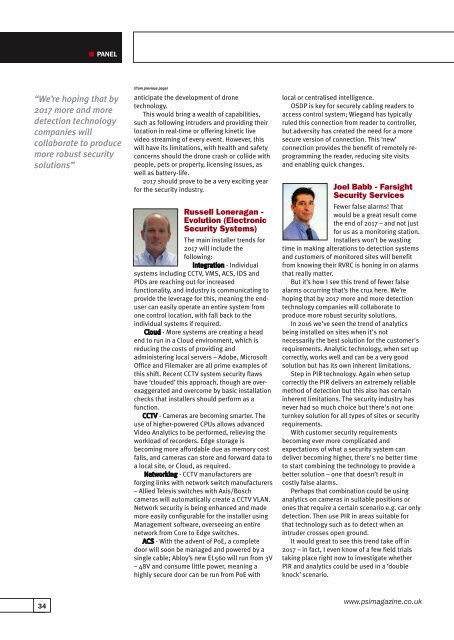PSIJan2017
You also want an ePaper? Increase the reach of your titles
YUMPU automatically turns print PDFs into web optimized ePapers that Google loves.
PANEL<br />
“We’re hoping that by<br />
2017 more and more<br />
detection technology<br />
companies will<br />
collaborate to produce<br />
more robust security<br />
solutions”<br />
(from previous page)<br />
anticipate the development of drone<br />
technology.<br />
This would bring a wealth of capabilities,<br />
such as following intruders and providing their<br />
location in real-time or offering kinetic live<br />
video streaming of every event. However, this<br />
will have its limitations, with health and safety<br />
concerns should the drone crash or collide with<br />
people, pets or property, licensing issues, as<br />
well as battery-life.<br />
2017 should prove to be a very exciting year<br />
for the security industry.<br />
Russell Loneragan -<br />
Evolution (Electronic<br />
Security Systems)<br />
The main installer trends for<br />
2017 will include the<br />
following:<br />
Integration - Individual<br />
systems including CCTV, VMS, ACS, IDS and<br />
PIDs are reaching out for increased<br />
functionality, and industry is communicating to<br />
provide the leverage for this, meaning the enduser<br />
can easily operate an entire system from<br />
one control location, with fall back to the<br />
individual systems if required.<br />
Cloud - More systems are creating a head<br />
end to run in a Cloud environment, which is<br />
reducing the costs of providing and<br />
administering local servers – Adobe, Microsoft<br />
Office and Filemaker are all prime examples of<br />
this shift. Recent CCTV system security flaws<br />
have ‘clouded’ this approach, though are overexaggerated<br />
and overcome by basic installation<br />
checks that installers should perform as a<br />
function.<br />
CCTV - Cameras are becoming smarter. The<br />
use of higher-powered CPUs allows advanced<br />
Video Analytics to be performed, relieving the<br />
workload of recorders. Edge storage is<br />
becoming more affordable due as memory cost<br />
falls, and cameras can store and forward data to<br />
a local site, or Cloud, as required.<br />
Networking - CCTV manufacturers are<br />
forging links with network switch manufacturers<br />
– Allied Telesis switches with Axis/Bosch<br />
cameras will automatically create a CCTV VLAN.<br />
Network security is being enhanced and made<br />
more easily configurable for the installer using<br />
Management software, overseeing an entire<br />
network from Core to Edge switches.<br />
ACS - With the advent of PoE, a complete<br />
door will soon be managed and powered by a<br />
single cable; Abloy’s new EL560 will run from 3V<br />
– 48V and consume little power, meaning a<br />
highly secure door can be run from PoE with<br />
local or centralised intelligence.<br />
OSDP is key for securely cabling readers to<br />
access control system; Wiegand has typically<br />
ruled this connection from reader to controller,<br />
but adversity has created the need for a more<br />
secure version of connection. This ‘new’<br />
connection provides the benefit of remotely reprogramming<br />
the reader, reducing site visits<br />
and enabling quick changes.<br />
Joel Babb - Farsight<br />
Security Services<br />
Fewer false alarms! That<br />
would be a great result come<br />
the end of 2017 – and not just<br />
for us as a monitoring station.<br />
Installers won’t be wasting<br />
time in making alterations to detection systems<br />
and customers of monitored sites will benefit<br />
from knowing their RVRC is honing in on alarms<br />
that really matter.<br />
But it’s how I see this trend of fewer false<br />
alarms occurring that’s the crux here. We’re<br />
hoping that by 2017 more and more detection<br />
technology companies will collaborate to<br />
produce more robust security solutions.<br />
In 2016 we've seen the trend of analytics<br />
being installed on sites when it's not<br />
necessarily the best solution for the customer's<br />
requirements. Analytic technology, when set up<br />
correctly, works well and can be a very good<br />
solution but has its own inherent limitations.<br />
Step in PIR technology. Again when setup<br />
correctly the PIR delivers an extremely reliable<br />
method of detection but this also has certain<br />
inherent limitations. The security industry has<br />
never had so much choice but there's not one<br />
turnkey solution for all types of sites or security<br />
requirements.<br />
With customer security requirements<br />
becoming ever more complicated and<br />
expectations of what a security system can<br />
deliver becoming higher, there's no better time<br />
to start combining the technology to provide a<br />
better solution – one that doesn’t result in<br />
costly false alarms.<br />
Perhaps that combination could be using<br />
analytics on cameras in suitable positions or<br />
ones that require a certain scenario e.g. car only<br />
detection. Then use PIR in areas suitable for<br />
that technology such as to detect when an<br />
intruder crosses open ground.<br />
It would great to see this trend take off in<br />
2017 – in fact, I even know of a few field trials<br />
taking place right now to investigate whether<br />
PIR and analytics could be used in a ‘double<br />
knock’ scenario.<br />
34<br />
www.psimagazine.co.uk

















